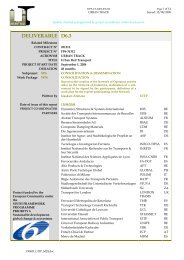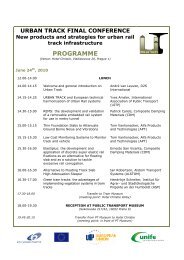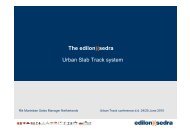DELIVERABLE 2.8 - urban track
DELIVERABLE 2.8 - urban track
DELIVERABLE 2.8 - urban track
You also want an ePaper? Increase the reach of your titles
YUMPU automatically turns print PDFs into web optimized ePapers that Google loves.
D0208_STIB_M24.doc<br />
TIP5-CT-2006-031312 Page 39 of 44<br />
URBAN TRACK Issued: August 13, 2008<br />
Quality checked and approved by project co-ordinator André Van Leuven<br />
By means of the marker signals, the time plots were recalculated to path plots and the evaluation of the<br />
vehicle’s relative accelerations related to the <strong>track</strong> induced accelerations is done for every channel. A<br />
deterministic and statistic evaluation is performed. The results are for the both directions:<br />
Table 3.1 Relative accelerations mean bottom of vehicle statistic and deterministic results travelling direction<br />
Empiric<br />
dispersions<br />
1. measurement<br />
06. August 2001<br />
2. measurement<br />
13. August 2001<br />
3. measurement<br />
27. August 2001<br />
FB-AU <strong>track</strong> 1<br />
Region A<br />
Clothoid with constant cant<br />
gradient<br />
0,109<br />
Viennese curve & cant gradient<br />
0,074<br />
Viennese curve & cant gradient<br />
0,086<br />
FB-AU <strong>track</strong> 1<br />
Region B<br />
Clothoid with constant cant<br />
gradient deterministic<br />
evaluation: Large oscillations<br />
AU-FB <strong>track</strong> 2<br />
Region C<br />
No measurement<br />
Undefined intermediate state Clothoid with constant cant<br />
gradient<br />
0,153<br />
Viennese curve & cant gradient<br />
deterministic evaluation:<br />
reproducible<br />
Table 3.2 Relative accelerations mean bottom of vehicle statistic results reverse direction<br />
Empiric<br />
dispersions<br />
1. measurement<br />
06. August 2001<br />
2. measurement<br />
13. August 2001<br />
3. measurement<br />
27. August 2001<br />
FB-AU <strong>track</strong> 1<br />
Region A<br />
Clothoid with constant cant<br />
gradient<br />
0,125<br />
Viennese curve & cant gradient<br />
0,090<br />
Viennese curve & cant gradient<br />
0,089<br />
FB-AU <strong>track</strong> 1<br />
Region B<br />
Clothoid with constant cant<br />
gradient:<br />
0,171<br />
Viennese curve & cant<br />
gradient<br />
0,124<br />
AU-FB <strong>track</strong> 2<br />
Region C<br />
No measurement<br />
Undefined intermediate state Clothoid with constant cant<br />
gradient<br />
0,142<br />
Viennese curve & cant gradient<br />
0,153<br />
Viennese curve & cant<br />
gradient<br />
0,132<br />
Beside the reduction of the dispersions the results of the measurements from the time plot show:<br />
At the bogie: the differences between the two types of geometry cannot be seen due to the large<br />
amplitudes; the running characteristics are dominating.<br />
Much higher accelerations at the roof than at the bottom.<br />
Vehicle body has smaller non-compensated accelerations on the newly tamped <strong>track</strong>; it is guided<br />
calmly.<br />
When compared to conventional clothoid curves, the vehicles run more deterministic than stochastic<br />
with much smaller amplitudes on the Viennese transition curves.<br />
The fluctuation of non-compensated acceleration is evident smaller and the empiric dispersions are<br />
reduced.<br />
Is valid independently from the travelling direction.








